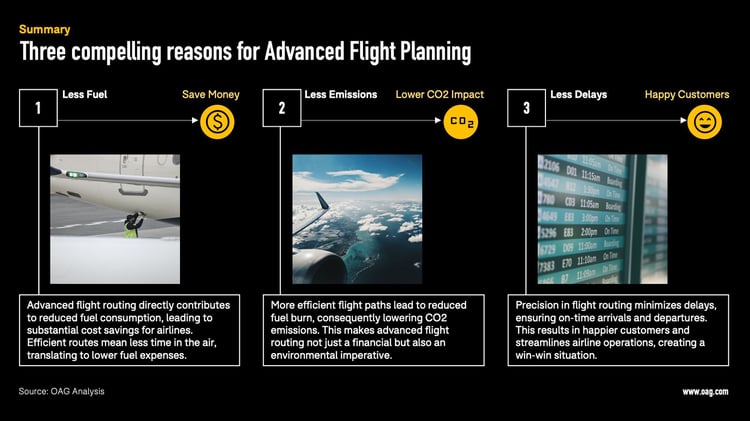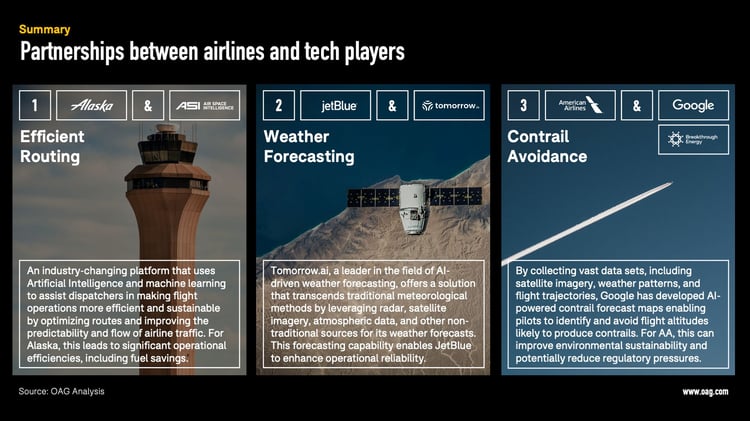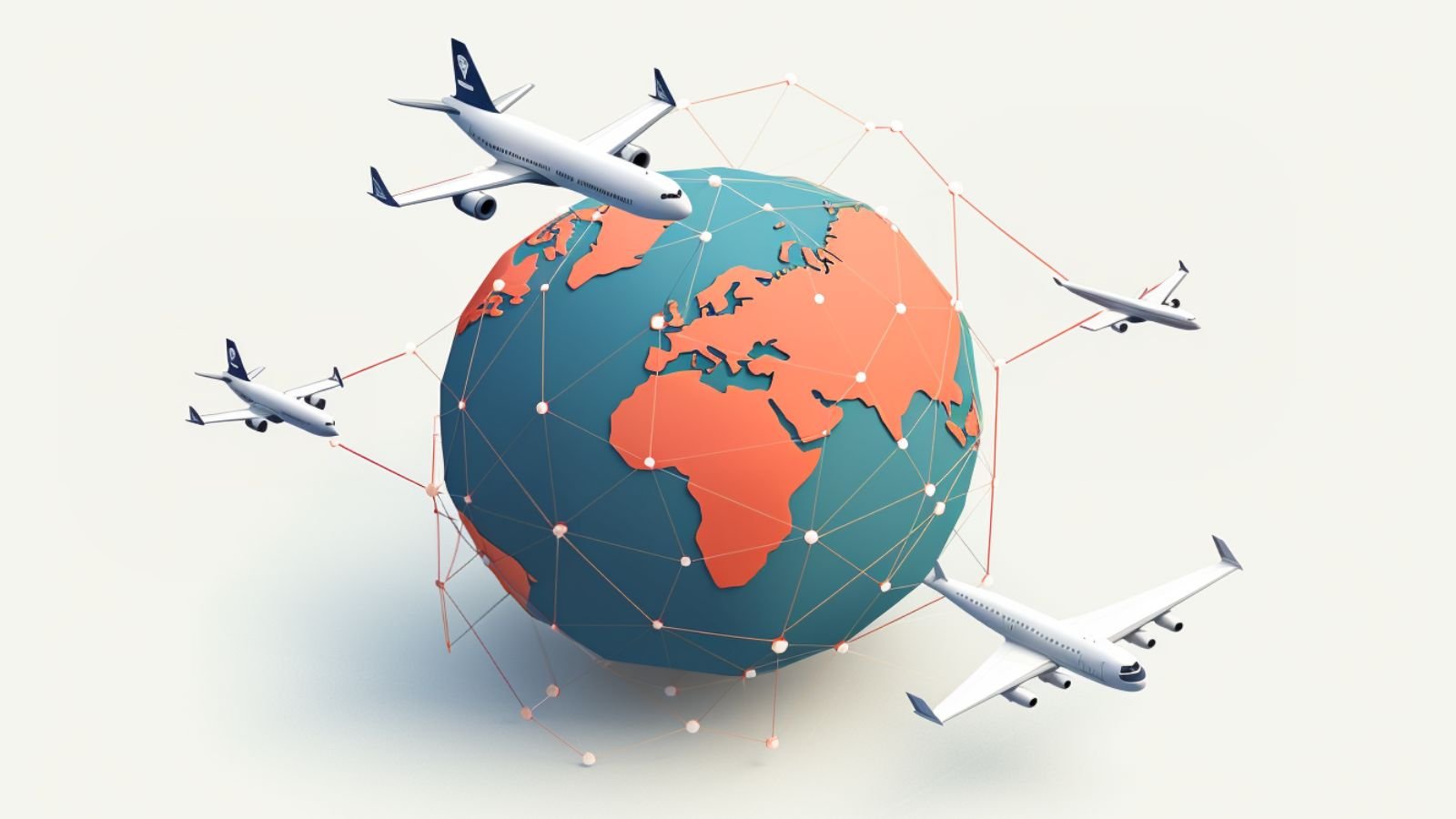As the aviation industry propels into a future marked by rapid technological advancements, innovation is reshaping not just the retail side of aviation (as we highlighted in our Airline Tech Transition Report), but the very core of airline operations. For example, advancements in the digital transformation of aircraft turnarounds are contributing to improvements in terminal operations. These developments are aimed at reducing wait times for passengers and streamlining operations, which could lead to more efficient use of aircraft and potential fuel savings, thereby contributing to the industry's environmental goals.
Another critical element within the vast machinery of aviation operations is flight planning. Here, innovation is not just a buzzword but a relentless pursuit, encompassing a range of technologies poised to redefine operational excellence and efficiency in the skies.
.png?width=750&height=422&name=Slide1%20(2).png)
Today, airline dispatchers within Network Operations Centers collaborate closely with pilots to ensure safe and efficient routing. Using mainly legacy airline computer systems, their task is to navigate a myriad of factors, including weather forecasts, air traffic, and aircraft performance, all while adhering to safety and air-traffic control compliance. While this setup has long ensured efficient operations, there's an emerging need for more integrated technology solutions that can enhance the precision and adaptability of flight planning, making the process more responsive to the dynamic aviation environment, as we will uncover below.
As part of this analysis, we will address the pressing challenges that require improved flight planning and spotlight several groundbreaking airline use cases. These examples, driven by data and technology, are pioneering new approaches to flight planning with remarkable effectiveness.
To get started, let’s focus on the very basics of flight planning. For flight operations, two key challenges dictate the rhythm: weather conditions and air traffic.
Both of these elements have become more complex to manage over the past few years.
1. More Severe Weather Considerations
The weather stands as an ever-present factor influencing flight schedules. Its unpredictable nature requires constant monitoring and adaptability. Statistically, weather plays the most significant role in operational disruptions. The FAA reports that over the last five years, weather conditions have accounted for nearly three-quarters of all flight delays in the United States.
.png?width=750&height=422&name=Slide2%20(1).png)
Extreme weather not only causes delays but can severely interrupt entire flight schedules. A recent example is Munich Airport, which had to suspend all flights during the first December weekend due to snow chaos in large parts of Southern Germany.
When weather disturbances are transient or localized, effective airspace management can usually mitigate their impact. However, the evolving climate crisis has led to more extreme and widespread weather phenomena, necessitating advanced airspace management strategies and next-generation systems to adapt and respond. One study found that the airline industry loses $13,000 USD every time a flight is canceled because of an uncontrollable weather event.
2. The Impact of Growing Air Traffic
The second critical factor influencing flight planning is the surge in air traffic. Although the pandemic temporarily halted this trend, air travel is swiftly rebounding to almost pre-pandemic levels, as highlighted in our OAG COVID-19 Air Travel Recovery tracker.
Looking into the future, even moderate projections suggest a 20-30% increase in air travel demand by 2030 compared to 2019 figures. As a result, the global commercial aviation fleet is expected to expand by about one-third, reaching over 36,000 operational aircraft by the early 2030s, according to Oliver Wyman.
.png?width=750&height=422&name=Slide3%20(1).png)
This significant uptick in air traffic intensifies the complexity of flight planning. It calls for more sophisticated systems to manage the burgeoning number of aircraft, including the integration of cargo flights and potentially even cargo drones. Moreover, route restrictions from Air Traffic Control (ATC) and regulatory constraints are likely to become more prevalent. Recent innovations, such as continuous descent approaches, high-altitude redesign in the western U.S., and new FAA ETOPS rules, indicate the evolving nature of airspace management. These constraints, coupled with the sheer scale of the calculations involved, present a “formidable challenge in optimization, even with today's advanced technologies,” according to Boeing.
ADVANCING FLIGHT PLANNING: THE TECH FOR CHANGE
The creation of a flight plan marks the beginning of every commercial airline flight, and the optimization of this plan is essential. It involves dynamic route optimization, accurate flight planning, efficient redispatch use, and dynamic airborne replanning.
While all airlines deploy computerized flight planning systems, those willing to invest in next-gen systems can significantly enhance customer satisfaction, profitability, and environmental sustainability. As the aviation sector evolves, such advanced systems leverage the power of Artificial Intelligence (AI), which is playing an increasingly pivotal role in aviation. Its capacity to process and analyze vast amounts of data, identify patterns, and offer real-time predictions is transforming flight route planning as we know it.

Recent advancements in AI and deep learning have further advanced capabilities and led regulatory bodies like the FAA and EASA to assess AI's potential application in various use cases in aviation.
Here are a few of the significant application areas directly related to flight routing and planning:
- Next-generation AI platforms utilize traffic information based on scheduled and active flights to formulate flight paths that dodge congested zones and adverse weather conditions, thereby minimizing delays. One such innovator, AVTECH, empowers airlines and air traffic control to optimize air traffic flow by integrating atmospheric conditions and precise aircraft positioning data. This not only reduces delays but also cuts fuel consumption, lowers emissions, and boosts punctuality.
- AeroCloud's Flight Management System is another exemplar, aggregating data from diverse sources, including ADS-B, to provide accurate, real-time flight information. Air traffic management solutions from companies like Saab and Air Space Intelligence (ASI) blend machine intelligence and user-friendly design to aid dispatchers, flight crews, and network managers in enhancing flight safety, efficiency, and sustainability.
- Weather radar technology, too, is undergoing a radical transformation. One example is Honeywell's IntuVue 3-D Weather Radar, which extends turbulence detection up to 60 nautical miles and predicts hail and lightning.
- Project Bluebird stands as another beacon of innovation in this field. This research initiative aims to develop the world's first AI-based system to collaborate with human air traffic controllers in managing UK airspace sections. It employs machine learning techniques, such as reinforcement learning, to assess air traffic control algorithms, predict flight trajectories, and identify potential aircraft conflicts. This data is crucial for strategic airspace planning and real-time decision-making support for ATC personnel.
AIRLINE USE CASES ADVANCING FLIGHT PLANNING
In the quest for optimal flight planning, airlines are increasingly turning to the power of AI and Machine Learning (ML). We will now explore three compelling use cases from different airlines. These examples serve as a testament to the innovative spirit pervading the airline industry and its commitment to embracing cutting-edge technology.

Case Study #1: Alaska Airlines' Partnership With Airspace Intelligence
In a pioneering move, Alaska Airlines has teamed up with San Francisco-based startup Airspace Intelligence to employ its platform, Flyways AI. This collaboration marks a turning point in the context of advanced flight operations, harnessing the potential of AI and ML for enhanced flight routing.
Unlike traditional methods focusing on individual flights, Flyways AI views air traffic as a dynamic, interconnected ecosystem. It continuously analyzes all scheduled and active flights across the U.S., identifying optimal routes that avoid turbulence and congestion. The platform's recommendations are not prescriptive but rather suggestive, empowering dispatchers with helpful options. The final decision to adopt these recommendations remains with the dispatchers, ensuring compliance with FAA protocols and operational safety. Alaska Airlines' adoption of Flyways AI is a testament to its commitment to innovation and sustainability, with tangible impacts paying off:
- According to the airline, within the first six months of testing Flyways AI, the system identified potential reductions in mileage and fuel usage for 64% of Alaska's mainline flights. Of these, dispatchers implemented 32% of the recommendations — a significant share, showing how much airline dispatchers value the AI-driven insights and efficiency gains offered by the system.
- As a result, in the same time frame, this initiative led to a substantial saving of 480,000 gallons of fuel, consequently avoiding 4,600 tons of carbon emissions.
- Impressively, between January and September 2022, Flyways AI contributed to an average time saving of 2.7 minutes per Alaska flight. While this might seem modest at first glance, it's a significant stride in enhancing on-time performance, a critical factor in passenger satisfaction.

Case Study #2: JetBlue's Advanced Weather Forecasting with Tomorrow.io
JetBlue's testing of Weather Tech, in partnership with Tomorrow.io, marks another powerful stride in optimizing flight planning.
Tomorrow.io, a leader in the field of AI-driven weather forecasting, offers a solution that transcends traditional meteorological methods by delivering hyper-accurate, location-specific forecasts in real-time, leveraging radar, satellite imagery, atmospheric data, and other non-traditional sources to generate weather forecasts. The platform enables airlines to anticipate and adapt to rapidly changing weather conditions much more accurately. The standard in weather forecasting has long relied on classical meteorologists and government data, which often lack the granularity and immediacy crucial for the airline industry, especially when it comes to predicting winds and lightning with enough specificity. Tomorrow.io's approach, however, tailors its forecasts to meet the more demanding needs of aviation, providing actionable insights that are both precise and timely.
JetBlue's integration of Tomorrow.io's technology at all of its ten major airports across the U.S. has yielded noteworthy operational improvements:
- Tomorrow.io’s forecasts have enabled JetBlue to avoid weather-related disruptions, leading to considerable cost savings. JetBlue estimates a monthly saving north of $300,000 USD across its hubs, amounting to an annual reduction in operational costs of close to $4 million USD.
- With real-time, accurate weather data at their fingertips, JetBlue's operations teams can make faster, more informed decisions. This efficiency translates to fewer delays and cancellations, directly impacting customer satisfaction.
JetBlue's partnership with Tomorrow.io exemplifies how specialized AI solutions, in this case, Weather Tech, can enhance aspects of airline operations that have traditionally relied on less sophisticated methods.
Case Study #3: American Airlines and Google Mitigate Contrails
In a groundbreaking initiative, American Airlines joined forces with Google and Breakthrough Energy, targeting an often-overlooked yet significant environmental issue in aviation: contrails. This collaboration aims to reduce the warming effects of aviation, demonstrating a commitment to sustainability that extends beyond traditional emission reductions.
Contrails, which are short for condensation trails, are cloud-like trails that aircraft leave in the sky. While they might seem harmless, they have a substantial impact on the environment. The 2022 IPCC report highlighted that contrails account for approximately 35% of aviation's warming effect, a significant figure that underscores the importance of addressing this issue.
By collecting vast data sets, including satellite imagery, weather patterns, and flight trajectories, Google has developed AI-powered contrail forecast maps. These maps enable pilots to identify and avoid flight altitudes likely to produce contrails. In a series of 70 test flights over six months, pilots utilized Google’s AI-based predictions alongside open-source contrail models from Breakthrough Energy. The objective was clear: to minimize the formation of contrails without compromising flight efficiency.
The results of this experiment are nothing short of impressive:
- Post-flight analysis revealed a significant reduction in contrail formation. Pilots successfully reduced contrail occurrence by 54%, marking a significant milestone in mitigating aviation's climate impact.
- This initiative marks the first verifiable instance where commercial flights have actively and effectively avoided contrail formation, thus setting a precedent for the industry and showcasing the impact of next-gen flight route planning beyond cost savings.
Navigating Tomorrow: AI's Role in Airline Operations
Flight planning is crucial in airline operations, and the integration of AI-powered models is revolutionizing this aspect. These technologies enable airlines to make more informed decisions, improving efficiency, sustainability, and passenger satisfaction.
Our case studies demonstrate how AI and ML can be used to optimize flight routes, predict weather patterns, manage air traffic, and even reduce environmental impacts like contrail formation. This is not just about operational efficiency; it's about advancing towards a more sustainable and passenger-centric future.
In this evolving landscape, accurate data is key. At OAG, we pride ourselves on offering the most comprehensive flight, airline schedules, and air logistics data, available in various formats, including APIs. We're at the forefront of this transformation, providing the tools and insights essential for navigating the future of aviation.




